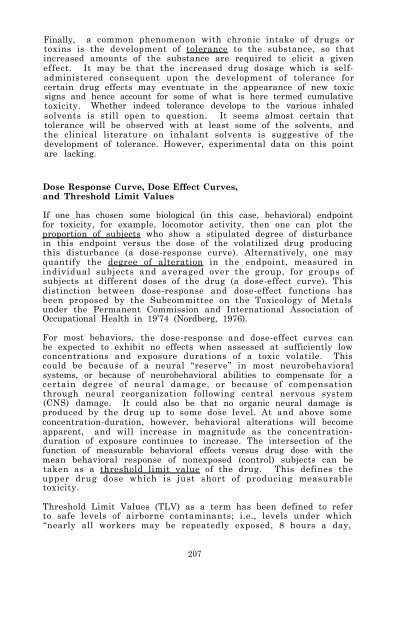Review of Inhalants - ARCHIVES - National Institute on Drug Abuse
Review of Inhalants - ARCHIVES - National Institute on Drug Abuse
Review of Inhalants - ARCHIVES - National Institute on Drug Abuse
You also want an ePaper? Increase the reach of your titles
YUMPU automatically turns print PDFs into web optimized ePapers that Google loves.
Finally, a comm<strong>on</strong> phenomen<strong>on</strong> with chr<strong>on</strong>ic intake <str<strong>on</strong>g>of</str<strong>on</strong>g> drugs or<br />
toxins is the development <str<strong>on</strong>g>of</str<strong>on</strong>g> tolerance to the substance, so that<br />
increased amounts <str<strong>on</strong>g>of</str<strong>on</strong>g> the substance are required to elicit a given<br />
effect. It may be that the increased drug dosage which is selfadministered<br />
c<strong>on</strong>sequent up<strong>on</strong> the development <str<strong>on</strong>g>of</str<strong>on</strong>g> tolerance for<br />
certain drug effects may eventuate in the appearance <str<strong>on</strong>g>of</str<strong>on</strong>g> new toxic<br />
signs and hence account for some <str<strong>on</strong>g>of</str<strong>on</strong>g> what is here termed cumulative<br />
toxicity. Whether indeed tolerance develops to the various inhaled<br />
solvents is still open to questi<strong>on</strong>. It seems almost certain that<br />
tolerance will be observed with at least some <str<strong>on</strong>g>of</str<strong>on</strong>g> the solvents, and<br />
the clinical literature <strong>on</strong> inhalant solvents is suggestive <str<strong>on</strong>g>of</str<strong>on</strong>g> the<br />
development <str<strong>on</strong>g>of</str<strong>on</strong>g> tolerance. However, experimental data <strong>on</strong> this point<br />
are lacking.<br />
Dose Resp<strong>on</strong>se Curve, Dose Effect Curves,<br />
and Threshold Limit Values<br />
If <strong>on</strong>e has chosen some biological (in this case, behavioral) endpoint<br />
for toxicity, for example, locomotor activity, then <strong>on</strong>e can plot the<br />
proporti<strong>on</strong> <str<strong>on</strong>g>of</str<strong>on</strong>g> subjects who show a stipulated degree <str<strong>on</strong>g>of</str<strong>on</strong>g> disturbance<br />
in this endpoint versus the dose <str<strong>on</strong>g>of</str<strong>on</strong>g> the volatilized drug producing<br />
this disturbance (a dose-resp<strong>on</strong>se curve). Alternatively, <strong>on</strong>e may<br />
quantify the degree <str<strong>on</strong>g>of</str<strong>on</strong>g> alterati<strong>on</strong> in the endpoint, measured in<br />
individual subjects and averaged over the group, for groups <str<strong>on</strong>g>of</str<strong>on</strong>g><br />
subjects at different doses <str<strong>on</strong>g>of</str<strong>on</strong>g> the drug (a dose-effect curve). This<br />
distincti<strong>on</strong> between dose-resp<strong>on</strong>se and dose-effect functi<strong>on</strong>s has<br />
been proposed by the Subcommittee <strong>on</strong> the Toxicology <str<strong>on</strong>g>of</str<strong>on</strong>g> Metals<br />
under the Permanent Commissi<strong>on</strong> and Internati<strong>on</strong>al Associati<strong>on</strong> <str<strong>on</strong>g>of</str<strong>on</strong>g><br />
Occupati<strong>on</strong>al Health in 19’74 (Nordberg, 1976).<br />
For most behaviors, the dose-resp<strong>on</strong>se and dose-effect curves can<br />
be expected to exhibit no effects when assessed at sufficiently low<br />
c<strong>on</strong>centrati<strong>on</strong>s and exposure durati<strong>on</strong>s <str<strong>on</strong>g>of</str<strong>on</strong>g> a toxic volatile. This<br />
could be because <str<strong>on</strong>g>of</str<strong>on</strong>g> a neural “reserve” in most neurobehavioral<br />
systems, or because <str<strong>on</strong>g>of</str<strong>on</strong>g> neurobehavioral abilities to compensate for a<br />
certain degree <str<strong>on</strong>g>of</str<strong>on</strong>g> neural damage, or because <str<strong>on</strong>g>of</str<strong>on</strong>g> compensati<strong>on</strong><br />
through neural reorganizati<strong>on</strong> following central nervous system<br />
(CNS) damage. It could also be that no organic neural damage is<br />
produced by the drug up to some dose level. At and above some<br />
c<strong>on</strong>centrati<strong>on</strong>-durati<strong>on</strong>, however, behavioral alterati<strong>on</strong>s will become<br />
apparent, and will increase in magnitude as the c<strong>on</strong>centrati<strong>on</strong>durati<strong>on</strong><br />
<str<strong>on</strong>g>of</str<strong>on</strong>g> exposure c<strong>on</strong>tinues to increase. The intersecti<strong>on</strong> <str<strong>on</strong>g>of</str<strong>on</strong>g> the<br />
functi<strong>on</strong> <str<strong>on</strong>g>of</str<strong>on</strong>g> measurable behavioral effects versus drug dose with the<br />
mean behavioral resp<strong>on</strong>se <str<strong>on</strong>g>of</str<strong>on</strong>g> n<strong>on</strong>exposed (c<strong>on</strong>trol) subjects can be<br />
taken as a threshold limit value <str<strong>on</strong>g>of</str<strong>on</strong>g> the drug. This defines the<br />
upper drug dose which is just short <str<strong>on</strong>g>of</str<strong>on</strong>g> producing measurable<br />
toxicity.<br />
Threshold Limit Values (TLV) as a term has been defined to refer<br />
to safe levels <str<strong>on</strong>g>of</str<strong>on</strong>g> airborne c<strong>on</strong>taminants; i.e., levels under which<br />
“nearly all workers may be repeatedly exposed, 8 hours a day,<br />
207
















